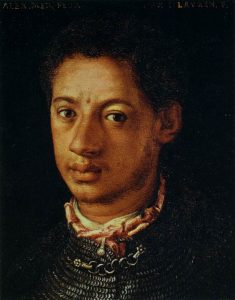
You can talk about the Renaissance, without talking about the The Medici Family. History doesn’t like to talk about is that the financial ruler of the western world — Alessandro de Medici, Duke of Penne and Duke of Florence and commonly called “Il Moro” was born to an African-Italian mother (a servant) and a white father.
Alessandro de’ Medici, called “Il Moro” (“The Moor”), was born in the Italian city of Urbino in 1510. His mother was an African slave named Simonetta who had been freed. Alessandro’s paternity is uncertain. Most sources name Lorenzo de’ Medici, ruler of Urbino. But Alessandro might also have been the son of Pope Clement VII, the brother of Lorenzo II who became the head of the Medici family after Lorenzo’s death. Clement VII chose the nineteen-year-old Alessandro to become the first Duke of Florence in 1529. He was the last member of the “senior” branch of the Medici to rule Florence and the first to be a hereditary duke.
Pope Clement at that time was at odds not only with the Florentines who had driven out the Medici family in 1497, but also with the emperor Charles V. To solidify the allegiance that the papacy owed to the Holy Roman Empire, Alessandro was named Duke of Florence and promised the emperor’s daughter Margaret. With the help of Charles V, Clement could restore the rule of the Medici family in Florence in 1530 and make Alessandro the first reigning Duke. Supported initially by the best families, Alessandro became an absolute prince, overthrowing the city’s’ republican government.
According to most historians the young duke’s reign did not begin very well. His arrogant personality, the bad behavior of his entourage, and his licentiousness — with both women and feasting — soon gave Alessandro an unsavory reputation. In addition, he made some highly unpopular political decisions including limiting the number of remunerative positions in his government. This decision alone forced many patrician families to go into exile and become enemies of his rule. Alessandro’s situation grew worse when his protector and benefactor Clement VII died in 1534.
His many enemies among the exiles declared that his rule was harsh, depraved and incompetent, an assessment debated by later historians. One relic of his rule sometimes pointed out as a symbol of Medici oppression is the massive Fortezza da Basso, today the largest historical monument of Florence. In 1535 the Florentine opposition sent his cousin Ippolito to appeal to Charles V against some actions of the Duke, but Ippolito died en route; rumors were spread that he had been poisoned at Alessandro’s orders.
In a late replay of the kind of medieval civil politics that had long revolved around pope and emperor, commune and lord, the Emperor supported Alessandro against the republicans. In 1536, Charles V married his natural daughter Margaret of Austria to Alessandro. For his own inclinations, Alessandro seems to have remained faithful to one mistress, Taddea Malaspina, who bore his only children Giulio de’ Medici (c. 1533/37-1600), who also had illegitimate issue, and Giulia de’ Medici, who married her cousin Bernardetto de’ Medici, Signore di Ottaiano, and had issue.
In 1537 his distant cousin Lorenzino de’ Medici, nicknamed “Lorenzaccio” (“bad Lorenzo”), assassinated him. (This event is the subject of Alfred de Musset’s play “Lorenzaccio.”) Lorenzino entrapped Alessandro through the ruse of a promised arranged sexual encounter with Lorenzino’s sister Laudomia, a beautiful widow.[12] For fear of starting an uprising if news of his death got out, Medici officials wrapped Alessandro’s corpse in a carpet and secretly carried it to the cemetery of San Lorenzo, where it was hurriedly buried.
In Valladolid (Spain), where the imperial court of Charles V was established, a solemn funeral was celebrated.
Lorenzino, in a declaration published later, said that he had killed Alessandro for the sake of the republic. When the anti-Medici faction failed to rise, Lorenzino fled to Venice, where he was killed in 1548. The Medici supporters (called “Palleschi” from the balls on the Medici arms) ensured that power then passed to Cosimo I de’ Medici, the first of the “junior” branch of the Medici to rule Florence.
***Reference: http://www.blackpast.org/gah/de-medici-alessandro-1510-1537#sthash.0CdaaZir.dpuf***

